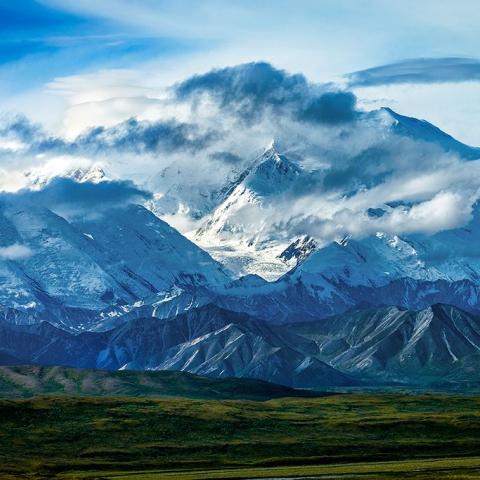
September 16, 2021, photo of eastern side of the Pretty Rocks landslide. The displacement of approximately 14 vertical feet seen below the person standing on the stable road surface (for scale) occurred over two weeks following the cessation of maintenance and road use on September 2, 2021/NPS
Engineers for the National Park Service and Federal Highways Administration believe it will take a bridge across the Pretty Rocks slide area to keep the full length of the Denali Park Road open in Denali National Park and Preserve.
Park officials say the slides that have occurred in that area since the 1990s will require that about half of the 92-mile road will remain closed for the 2022 visitor season. Most of Denali will remain open for visitors, and buses will continue to provide access to mile 43 of the Denali Park Road. The long-term solution is a permanent bridge over the slide area, originally planned for 2023. The NPS and the Federal Highways Administration have been working to identify funding and contracting opportunities to accelerate the overall project schedule into 2022 and complete the permanent bridge earlier than initially planned.
“We look forward to getting started on the long-term solution at Pretty Rocks. Meanwhile, Denali is ready for visitors in 2022. We will continue to have access to great wildlife viewing, views of Denali, front-country trails, and backcountry hiking and camping,” said Brooke Merrell, the park's deputy superintendent. "Denali National Park and Preserve will continue to work with inholders, neighbors, and partners to ensure an unforgettable Denali experience during construction.”
During the 1990s, the Pretty Rocks landslide caused small cracks in the road surface, increasing to three and a half inches per day by 2020, a park release said.
Of some 150 unstable sites on the Park Road, Pretty Rocks is the “problem child,” relentlessly encroaching even after it’s shored up, park geologist Denny Capps told the Traveler's Rita Beamish in 2019.
With warming temperatures and increased precipitation trends, by 2021 the slide was moving at a rate of more than 0.65 inches per hour. On August 24, 2021, the NPS determined that it could no longer maintain a safe road surface at that accelerated rate of movement and the road was closed to traffic past mile 43.
Based on climate data from 1950 to 2010, Denali National Park has experienced a temperature increase of 7.7°F ± 2.0°F (4.3°C ± 1.1°C) per century, the highest of all national parks (Gonzales, et al, 2018). A recent shift in mean annual temperatures in the area to near 32°F (0°C) (Swanson et al., 2021) combined with heavy rainfall events is believed to be causing permafrost to thaw, resulting in the recent acceleration of many landslides in Denali. In the case of Pretty Rocks Landslide, climate change has likely taken a problem previously solved by minor road repairs and made it difficult to overcome with short-term solutions. Temperature and precipitation increases are likely to continue, and the rate may worsen, over the coming decades.
While these changes were predicted by modelers (Rupp and Loya, 2009), the magnitude of the change has been greater than expected. For example, the area where Eielson Visitor Center (Mile 66 [km 106]) reached an average mean annual temperature of 31.6°F (0.2 °C) from 2015-2019 (Sousanes, 2020); this exceeds the temperature of 29.8°F (-1.2°C) projected for 2040 by Rupp and Loya (2009).--NPS
Since road maintainance ended this past September 6, the roadbed has slumped approximately 30 feet, already exceeding the total movement seen from October 2020 to March of 2021. Given the acceleration trend, the NPS expects landslide movement over this winter will exceed the park’s ability to restore or maintain the road surface to safely allow for bus traffic.
The potential availability of 2022 funding allows the park to take advantage of a “design and build” engineering solution with construction beginning in 2022. Accelerating the overall project schedule may allow for the return of a full season much earlier than projected.




 Support Essential Coverage of Essential Places
Support Essential Coverage of Essential Places







Add comment